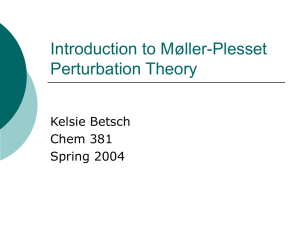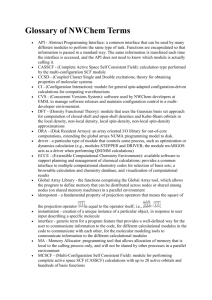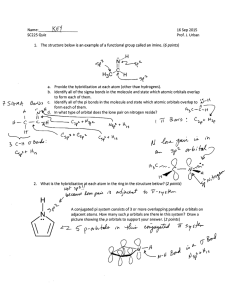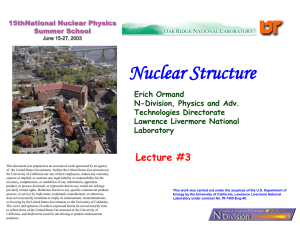Introduction to computational quantum mechanics Lecture 6: Simen Kvaal
advertisement
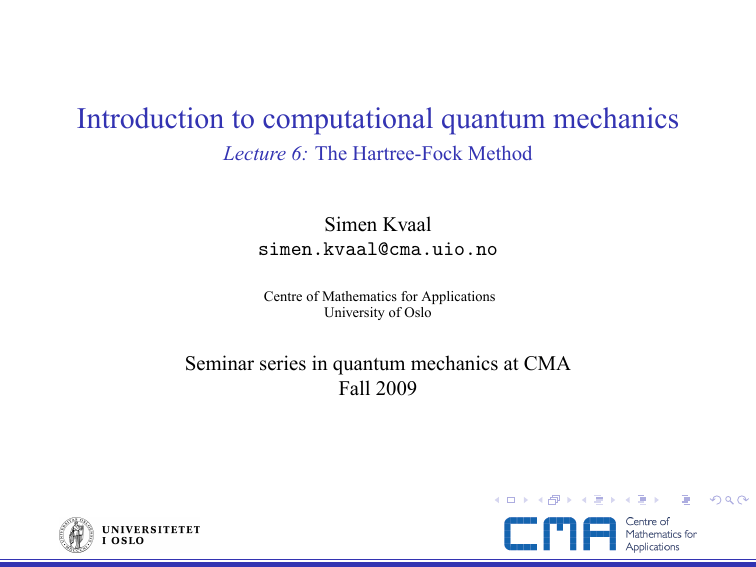
Introduction to computational quantum mechanics
Lecture 6: The Hartree-Fock Method
Simen Kvaal
simen.kvaal@cma.uio.no
Centre of Mathematics for Applications
University of Oslo
Seminar series in quantum mechanics at CMA
Fall 2009
Outline
Setting
The Hartree-Fock method
Abstract results on the Hartree-Fock method
References
Outline
Setting
The Hartree-Fock method
Abstract results on the Hartree-Fock method
References
Hamiltonian, Hilbert-space and basis
In this lecture, we will use the following conventions:
I We consider N particles in d dimensions, i.e.:
H = Π− L2 (Rd × S)⊗N
I
The Hamiltonian H is given by
N
H=
∑ H0,k + ∑
k=1
I
Vij
(ij), i6=j
Typically,
1
H0 = − ∇2 + W(~r),
2
and
Vij =
2
W(~r) ∈ Lloc
(Rd )
1
k~ri −~rj k
but other (nicer) interactions are possible as well.
Spectrum of Hamiltonian
We assume that the spectrum is on one of the following forms:
Figure: Possible and common speectra of the Hamiltonian H: Purely discrete
spectrum (possibly unbounded and/or infinitely many eigenvalues), or various
discrete spectra below a continuous spectrum.
Note: inf{σc (H)} = E0 is an eigenvalue; the ground state
eigenvalue/energy. The eigenvector is called the ground state. (It might be
several, but usually it is not.)
Variational characterization of σ(H)
We recall the well-known variational characterization of the eigenvalues
below σc (H):
Theorem
Suppose H = H ∗ is bounded from below.
Define a sequence {(φk , µk )}, k = 1, · · · by:
µk = min hψ|Hψi =: hφk |Hφk i ,
ψ∈Mk
where
Mk = {ψ ∈ D(H) : kψk = 1, hψ|φj i = 0, for j < k.}
Then for every k exactly one of the following holds:
1. There is j > k with µj > µk , and µk ∈ σd (H). Also, φk is an eigenvector
with eigenvalue µk .
2. µj = µk for all j > k, and µk = inf σc (H) (the bottom of the continuous
spectrum.) There are then only finitely many eigenvalues below σc (H).
Variational principle for the ground state
I
From this, we note that the ground state energy can be characterized by:
E0 = inf {hψ|Hψi : ψ ∈ D(H), kψk = 1}
I
Select a subset M ⊂ D(H) ⊂ H of trial functions, and note that
hψ|Hψi
inf
: ψ ∈ M =: E0,M ≥ E0 .
hψ|ψi
I
Quite a lot of numerical approaches to computing E0 is based on this
variational principle with good choices of M .
Outline
Setting
The Hartree-Fock method
Abstract results on the Hartree-Fock method
References
Spectrum of non-interacting particles
I
Suppose Vij ≡ 0, so that the particles are non-interacting:
N
H = ∑ H0 (i).
i=1
I
I
I
I
Let φα ∈ H1 be eigenvectors of the one-particle operator H0 ,
α = 1, 2, . . .. Suppose α are the eigenvalues (in increasing order).
“Easy” to see, by separation of variables that the ground state of H is
given by:
φ1 (x1 ) φ1 (x2 ) · · · φ1 (xN ) .. ..
.
1 φ2 (x1 )
. Ψ0 (x1 , x2 , · · · , xN ) = √ .
.. N! ..
. φN (x1 ) φN (x2 ) · · · φN (xN )
That is, Ψ0 is a Slater determinant with the eigenfunctions of H0 as
orbitals.
(In fact, the spectral decomposition of H for non-interacting systems is
determined by that of H0 by a simple generalization.)
Hartree-Fock approximation
The Hartree-Fock approximation E0HF to E0 is now defined as follows:
I Let M0 be the set of all Φ ∈ H that can be written as Slater
determinants:
o
n
√
M0 = Φ = det[φα (xk )]/ N!, : φα ∈ H1 orthonormal , α = 1, · · · , N
I
Let M = M0 ∩ D(H).
Now, by the variational principle:
E0 ≤ E0HF := E0,M = inf {hψ|Hψi : ψ ∈ M }
I
The minimizing function ΦHF (if it exists) is now a Slater determinant
composed of N Hartree-Fock orbitals ψα .
Nonlinear eigenvalue problem for HF-orbitals
I
I
It turns out we can derive, using the method of Lagrange multipliers, a
nonlinear eigenvalue problem for ψα .
This equation reads:
[H0 + F(ψ1 , · · · , ψN )]ψα = α ψα ,
where the Fock operator F is given by:
"Z
N
#
∑ |ψα (y)|2 V(x, y)dy
(Fφ)(x) :=
φ(x)
α=1
−
"Z
N
#
∑ ψα (y)φ(y)V(x, y)dy
ψα (x)
α=1
I
One seeks the smallest HF orbital energies {α } such that the equation
is fulfilled.
Self-consistend field method (SCF)
I
Introducing a truncated basis {ej }Kj=1 for H1 gives a nonlinear matrix
eigenvalue problem (Roothan equations):
[H0 + F(U)]U = UE,
(SCF equation)
where E = diag(1 , · · · , N ) and
Uk,α = hej |ψhα i
I
I
I
As soon as a minimizing set {ψα } is found, the operator H0 + F(ψα ) is
a self-adjoint one-particle operator
Note that, F represents the optimal one-particle approximation to the
full problem, in a very specific sense. Hartree-Fock is therefore called a
mean field method
Its eigenfunctions (including ψα ) are called canonical orbitals and form
a common computational basis replacing {ej } in many problems
Orbital energies and SCF iteration
SCF equation typically solved
using substition iterations:
1. Choose initial guess U0 .
2. For k = 0, 1, 2, . . ., iterate
linear EVP until convergence
(“self-consistency”):
[H0 +F(Uk )]Uk+1 = Uk+1 Ek+1
This scheme typically shows linear
local convergence:
U = Uk + O(e−µk )
Sample problem
I
I
We consider a simple problem for N particles; H1 = L2 (R).
Hamiltonian:
H0 = −
1 ∂2
1
+ x2 ,
2 ∂x2 2
V(i, j) = λ p
N
N
i=1
i<j
1
|xi − xj |2 + δ2
H = ∑ H0 (i) + ∑ V(i, j)
I
Eigenfunctions of H0 (Harmonic oscillator):
ej (x) = Nn Hn (x)e−x
I
I
2 /2
(Hermite functions)
Eigenvalues are n0 = n + 1/2.
For λ = 0, system is noninteracting and exact ground state is Slater
determinant of N first ej . HF is then, obviously, exact.
M ATLAB implementation: simple hf.m
Sample problem: convergence history of SCF iterations
Error estimate
0
10
λ=1
−2
λ=5
10
λ=15
||Uj−Uj−1|| (operator norm)
−4
10
−6
10
−8
10
−10
10
−12
10
−14
10
0
5
10
15
20
25
30
iteration number j
35
40
45
50
Figure: We set δ = 0.25 and solve SCF problem for λ ∈ {1, 5, 15}, N = 4 particles.
Notice linear regime and plateau of numerical noise.
Sample problem: converged orbitals
HF orbitals (−) and initial orbitals (−−)
0.015
ψα(x)2 and ψ0,α(x)2
0.01
0.005
0
−4
−3
−2
−1
0
x
1
2
3
4
Figure: HF orbitals for λ = 15. Notice widening of λ = 0 orbitals due to repulsion
between particles.
Variants of HF
I
I
I
Restricted HF (electronic systems): enforces pairs of electrons to
occupy the same spatial orbital, but with opposite spins. A further
approximation reducing computational cost.
Multiconfiguration HF: M consists of a finite linear combination of
Slater determinants, whose orbitals are unknown
And many more . . .
Outline
Setting
The Hartree-Fock method
Abstract results on the Hartree-Fock method
References
Result for neutral atoms and molecules, and positive ions
and radicals
E. Lieb and B. Simon (1977) proved the following:
Theorem
Consider the molecular Hamiltonian in the Born-Oppenheimer
approximation:
!
N
N
zj
1 2 M
1
H = ∑ − ∇i + ∑
+∑
~
2
k~
r
−~
i rj k
ri k
i<j
j=1 kRj −~
i=1
~ j (fixed parameters). Let
Here, zj is the charge of nucleus j located at R
Z = ∑j zj . Then, a minimizing solution to the HF equation exists whenever
~ j,
N < Z + 1. The orbitals ψα (~r, s) are infinitely differentiable away from R
and falls of exponentially. They are globally Lipschitz and lie in
D(−∇2 ) = H 2 (R3 × {−1, 1}).
Outline
Setting
The Hartree-Fock method
Abstract results on the Hartree-Fock method
References
References
Szabo, A. and Ostlund, N.S.
Modern Quantum Chemistry
Dover
1989
Lieb, E. and Simon, B.
The Hartree-Fock Theory for Coulomb Systems
Commun. Math. Phys 53, pp. 185–94
1977
Lions, P.-L.
Solutions of Hartree-Fock equations for Coulomb systems
Commun. Math. Phys 109, pp. 33–97
1987
